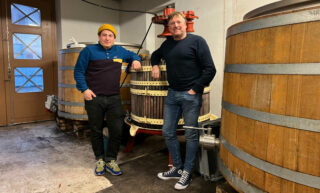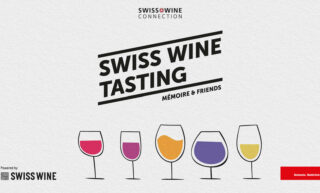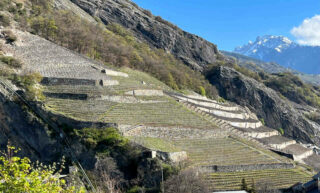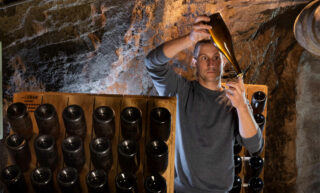As the summers are becoming increasingly warm, winegrowers are searching for vineyards where a good level of freshness in the grapes can be maintained, typically higher up the hill or on northern slopes. For the same reason, wine buyers have an increased interest in Alpine regions. Savoie and Valtellina, for example, are enjoying their moment in the limelight. But Switzerland remains under the radar – a missed opportunity, because the Helvetic confederation doesn’t only have cool sites, but also a cornucopia of indigenous varieties and talented winemakers. And despite its reputation, there are bargains to be found, especially in the higher segment.
Last year I visited Marie-Thérèse Chappaz, one of Switzerland’s internationally best-known vintners. We tasted her wines on the terrace of her beautiful old house on the outskirts of the village of Fully, overlooking the dry and warm Rhône Valley to the south. I had a particular interest in her Syrah. As the south-facing slopes of Valais are becoming too hot for Pinot Noir, which at 25 percent is Switzerland’s most planted variety – Syrah, a typical Rhône variety, is seeing an increase in popularity. Chappaz’s best Pinot Noir is now sourced from the north-facing vineyards on the other side of the valley.
This shift demonstrates two things. Switzerland isn’t immune to rising temperatures, but, in some places, vintners can shift their grape production to cooler sites. Valais, after all, has vineyards up to 1200 m.a.s.l. On the other hand, vintners could also choose different, more heat-loving varieties.
The King of Rare Varieties
But the Swiss also have another weapon: going indigenous. Varieties like Petite Arvine, Humagne Blanc, Cornalin and Humagne Rouge are all native to canton Valais, and typically respond well to the local conditions and the warming climate. Chappaz’s sweet wine from Petite Arvine, Switzerland’s first and, for now, only wine that has received Robert Parker’s coveted 100 points, has developed cult status. Denis Mercier makes a fantastic Cornalin, and Robert Taramarcaz of Domaine des Muses is an expert at Humagne, both red and white. But the king of rare varieties is the octogenarian José-Marie (or Chosy) Chanton, whose winery is located at the eastern end of the Swiss Rhône Valley. He finished his enological studies with a research paper on the local varieties in his native Visp. With varieties like Lafnetscha, Himbertscha, Gwäss (Gouais), Plantscher and Resi (Rèze), Chanton Weine has become a guardian of indigenous and sometimes almost extinct grapes.
Chosy Chanton
Chasselas heaven and a better Burgundy
Switzerland’s pride and joy remains Chasselas, the country’s second most planted grape. With its roots on the northern side of Lake Geneva, the canton of Vaud is the Hochburg of this rather neutral and soft variety that has a surprisingly high aging potential. Louis Bovard’s Médinette and Domaine La Colombe’s Brez are cases in point. A vertical of Médinettes last year at the Mémoire & Friends Swiss wine fair in Zürich was an eyeopener.
Just north of Vaud, the Three Lakes Region has specialized in Pinot Noirs. The chalky, southeast-facing Jura provides excellent conditions for this fickle variety. The local vintners consider their region to be a better version of Burgundy – slightly cooler, but without hail and spring frost. Unsurprisingly, a Burgundian approach to winemaking is typical, but the soils (in some places containing some glacier moraine), the slightly cooler weather (the vineyards are situated at around 400 m.a.s.l.), and the use of Swiss clones, in particular Mariafeld, give the wines a Swiss touch.
Extreme weather events
Annie Rossi, the oenologist at Grillette and Domaine Grisoni, says: “Rising temperatures aren’t our biggest problem here in the Three Lakes Region, but extreme weather events are, in particular excessive rainfall within a short period of time and extended periods of drought. Nonetheless,” she continues, “we do adjust our vineyard management. We also do research into Pinot Noir clones that are better suited to the changing climate, and we are noticing that Merlot is doing increasingly well in our region. Moving up the vineyards is under discussion, but zoning rules are restrictive. For now, Pinot Noir remains king.”
Château d’Auvernier and Domaine de La Maison Carrée (a member of La Renaissance des Appellations) make deeply satisfying examples. Another specialty of the region is Œil de Perdrix, a rosé of Pinot Noir that may contain a small amount of Pinot Blanc or Pinot Gris. Château d’Auvernier has made its production into an art. The winery vinifies its plots separately and in different ways. Several times per year they blend and bottle the wine to create a more or less uniform style and to meet continuous demand.
German-speaking Switzerland
With more than 50 percent, Pinot Noir is even more dominant in the Deutschschweiz, the German speaking part of Switzerland. In the Rhine Valley in Graubünden, Switzerland’s trilingual easternmost canton, wineries like Adank, Donatsch, Gantenbein, Obrecht, Boner and Wegelin produce world-class Pinots. Were it not for the strict protection of the forests, vintners would plant their vines higher up the mountain. However, due a large amplitude between day and night temperatures, the pressure on the Bündner winemakers is less high than in Valais.
The canton is also home to Completer, a high-acidity and high-sugar variety that lends itself to many different styles of winemaking. Donatsch’s Completer has evolved over the years from a Spätlese with a bit of residual sugar to a drier style. Since last year, the winery also makes a sweet wine out of it. Obrecht uses a solera system made up of spherical clay pots to make a lovely multi-vintage version. A little further west, around Zürich, Räuschling is another native, high-acidity jewel of which Schwarzenbach crafts a beautiful, refreshing wine.
Near Basel, Weingut Riehen, run by Silas Weiss, a mentee of Hanspeter Ziereisen from neighbouring Baden, gives the northwest of the country new momentum. In a recent blind tasting, his Le Grand beat a respectable line-up of Swiss and international Chardonnays. Weingut Riehen exemplifies not only that Swiss wine can be of high quality, but also that there is a young generation that brings a new dynamic to the rather isolated Alpine wine country.
Finally, there is the Italian speaking canton of Ticino that has built its reputation on Merlot, Switzerland’s fourth most important variety. Unperturbed by the warm and humid climate, wineries like Zündel are farming organically to make their lovely pure low-intervention wines.
Swiss wine regions ©Swiss Wine Promotion
International awareness
The avant-garde of Swiss vintners is now on a mission to break out of their (self-chosen) isolation. For winegrowers like Chappaz or Adank it’s a matter of (benign) national pride to show the world that Swiss wine deserves a place at the table. Or as Jasmin Schmid from Swiss Wine Promotion once told me: to have Swiss wines on the menu of restaurants in Tokyo, London and New York, helps to underscore Swissness, the Swiss quality brand. Most vintners also realize that to build a brand you need international exposure. In the low to mid-price range, competition with countries like France, Chile, Spain, Germany or Portugal, may be near impossible, but in the mid to higher segment, say from DKK 300 and up, there is good value to be found. Availability is another matter. With 15 thousand hectares of vineyards, Switzerland is as big as Alsace. Portugal, to give another example, has thirteen times more. In other words, buyers have to be prepared to accept small amounts.
No vineyard classification
The top wineries are generally aligned to the international trend of making terroir-expressive wines. But unlike neighboring countries, there is no drive to formalize a system of Erste and Grosse Lagen, or Premiers and Grands Crus. The demarcation of appellations is largely political and follows the borders of the cantons and, in some cases, municipalities. The Swiss tendency to find a compromise for everything dictates that, if a vineyard classification were to be pursued, there has to be something in it for everybody. And thus, terroir-aware vintners make single vineyard wines and label them with the vineyard’s names, but there is no official hierarchy. The market and the press implicitly decide which vineyards really excel.
The French-speaking cantonal appellation of Vaud is a bit of an exception. It is divided in four subregional designations of origin, among which are Lavaux, Chablais, and La Côte. The first one has two Grand Crus: Dézaley and Calamin.
Buyers and collectors who want to hedge against climate change would do well to keep an eye on Switzerland. For your day-to-day wines you may want to turn to other countries, but for special occasion wines, the Alpine republic has a lot to offer.
Seven recommended wines:
Weingut Riehen – Le Grand Chardonnay, CHF 69.00 / EUR 72.30
Vintner Silas Weiss isn’t afraid of a bit of skin contact. Phenolics will help preserve the wines. Here are a few notes of several vintages I tasted.
“Creamy, powerful, a bit phenolic, opulent” (2018)
“Compared to the 2018 vintage more mineral and leaner” (2020)
Weingut Hansruedi Adank – Spondis Pinot Noir, CHF 59.00 / EUR 61.80
Spondis is a south- to west-oriented cru with poor schist soils with 60-year-old vines.
More than half of the wine is made of whole bunches, aged in 100 percent barrique, of which 60 percent new, and filtered without filtration.
About the 2021 vintage I wrote: “Chalky, fresh, finely structured, slightly spicy, a bit reductive, good intensity of strawberry and dark red cherry. Still young, needs time.”
Domaine de La Maison Carrée – Œil de Perdrix, CHF 20.00 / EUR 21.00
Two to three days on the skins.
Vintage 2022: Lots of strawberry, some grip, a bit creamy and yeasty, good freshness, vaguely nutty. Commanding without being powerful. Gastronomic rosé.
Louis Bovard – Médinette Grand Cru Dézaley Chasselas, CHF 33.00 / EUR 34.60
Not until they are properly aged it is that Bovard’s Médinettes start to show they full potential. In its youth, expect a slightly elevated acidity and concentration compared to many of its peers.
Here are a few notes from the 2002, 2005, 2008 and 2011 vintages I tasted.
“Nutty, a bit savory (almost woody), elegant and fresh, lean” (2002).
“Complete, still a bit closed, balanced, hint of blanched white almond bitterness” (2005).
“Umami-ish, a suggestion of lychee and a dollop of butter” (2008)
“Bruised apple, hay, dry”
Weingut Obrecht – Completer Solera, CHF 70.00 / EUR 73.40
Aged in a solera system consisting of mostly Clayver pots. The solera started in 2018.
Nutty, chalky, then becoming soft with firm core of acidity, dollop of butter, apple, power, a bit grapey.
Jean-René Germanier – Cayas Syrah Réserve, CHF 49.00 / EUR 51.30
Vintage 2019: Floral, dark-berried nose with black cherries, stony, toasty element and some slightly herbal sensations. Well-structured, broad. Some spice, vanilla and clove. Primary fruit lurks in the background.
Vintage 2014: Complex nose with hints of mint, mushroom, dried fruits, leather coffee, some red bell pepper, cocoa. Silky tannins, rounded freshness, some sweet spice and herbs, pencil graphite, with some tobacco and smokey bacon on the long finish.
Denis Mercier – Cornalin, CHF 53.00 / EUR 55.55
After tasting the 2013 vintage in August 2023 I wrote: “Sensation of little, slightly dried dark berries, lots of freshness, hints of juniper, intense fine tannins, rustic touch, nice density combined with elegance.” Younger vintages typically need more time.
A version of this article (in Danish) was published in Din Vin Guide, issue 44, August 2024.








Comments